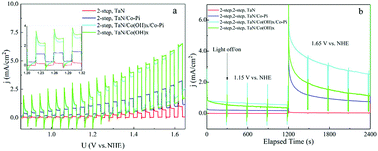Ta3N5/Co(OH)x composites as photocatalysts for photoelectrochemical water splitting
Abstract
Ta3N5 nanotubes (NTs) were obtained from nitridation of Ta2O5 NTs, which were grown directly on Ta foil through a 2-step anodization procedure. With Co(OH)x decoration, a photocurrent density as high as 2.3 mA cm−2 (1.23 V vs. NHE) was reached under AM1.5G simulated solar light; however, the electrode suffered from photocorrosion. More stable photoelectrochemical (PEC) performance was achieved by first loading Co(OH)x, followed by loading cobalt phosphate (Co–Pi) as double co-catalysts. The Co(OH)x/Co–Pi double co-catalysts may act as a hole storage layer that slows down the photocorrosion caused by the accumulated holes on the surface of the electrode. A “waggling” appearance close to the “mouth” of Ta2O5 NTs was observed, and may indicate structural instability of the “mouth” region, which breaks into segments after nitridation and forms a top layer of broken Ta3N5 NTs. A unique mesoporous structure of the walls of the Ta3N5 NTs, which is reported here the first time, is also a result of the nitridation process. We believe that the mesoporous structure makes it difficult for the nanotubes to be fully covered by the co-catalyst layer, hence rationalizing the remaining degradation by photocorrosion.

- This article is part of the themed collection: Solar chemistry & photocatalysis: environmental applications – SPEA10


 Please wait while we load your content...
Please wait while we load your content...